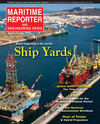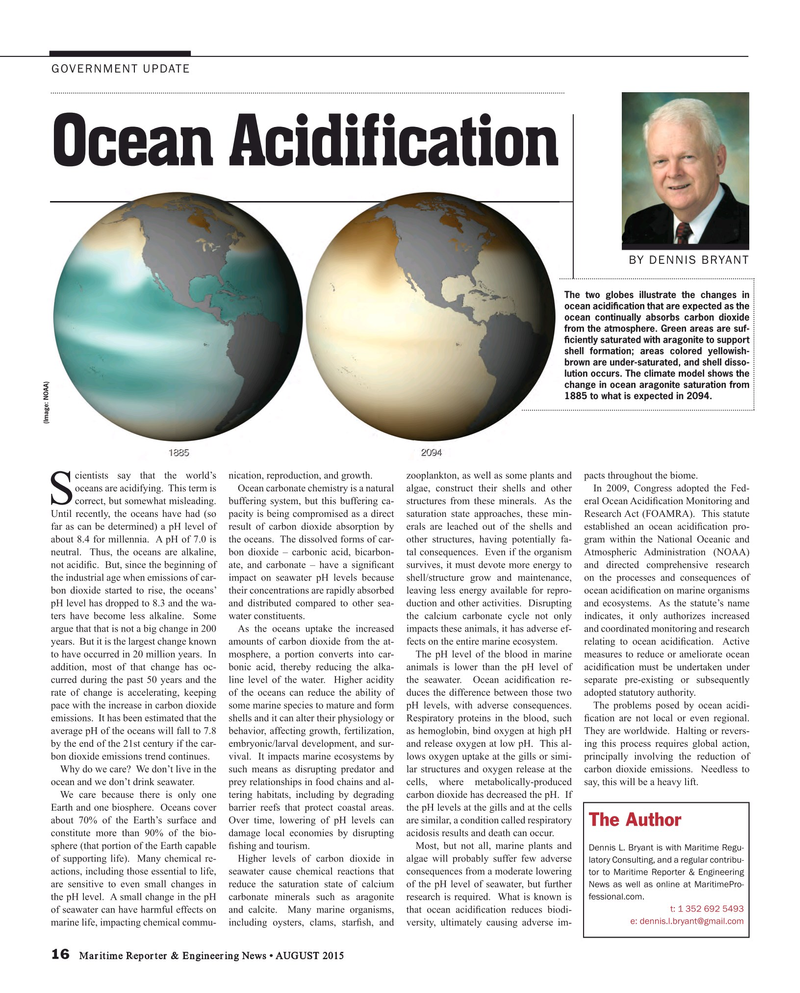
Page 16: of Maritime Reporter Magazine (August 2015)
Shipyard Edition
Read this page in Pdf, Flash or Html5 edition of August 2015 Maritime Reporter Magazine
GOVERNMENT UPDATE
Ocean Acidi? cation
BY DENNIS BRYANT
The two globes illustrate the changes in ocean acidi? cation that are expected as the ocean continually absorbs carbon dioxide from the atmosphere. Green areas are suf- ? ciently saturated with aragonite to support shell formation; areas colored yellowish- brown are under-saturated, and shell disso- lution occurs. The climate model shows the change in ocean aragonite saturation from 1885 to what is expected in 2094. (Image: NOAA) cientists say that the world’s nication, reproduction, and growth. zooplankton, as well as some plants and pacts throughout the biome.
oceans are acidifying. This term is Ocean carbonate chemistry is a natural algae, construct their shells and other In 2009, Congress adopted the Fed-
Scorrect, but somewhat misleading. buffering system, but this buffering ca- structures from these minerals. As the eral Ocean Acidi? cation Monitoring and
Until recently, the oceans have had (so pacity is being compromised as a direct saturation state approaches, these min- Research Act (FOAMRA). This statute far as can be determined) a pH level of result of carbon dioxide absorption by erals are leached out of the shells and established an ocean acidi? cation pro- about 8.4 for millennia. A pH of 7.0 is the oceans. The dissolved forms of car- other structures, having potentially fa- gram within the National Oceanic and neutral. Thus, the oceans are alkaline, bon dioxide – carbonic acid, bicarbon- tal consequences. Even if the organism Atmospheric Administration (NOAA) not acidi? c. But, since the beginning of ate, and carbonate – have a signi? cant survives, it must devote more energy to and directed comprehensive research the industrial age when emissions of car- impact on seawater pH levels because shell/structure grow and maintenance, on the processes and consequences of bon dioxide started to rise, the oceans’ their concentrations are rapidly absorbed leaving less energy available for repro- ocean acidi? cation on marine organisms pH level has dropped to 8.3 and the wa- and distributed compared to other sea- duction and other activities. Disrupting and ecosystems. As the statute’s name ters have become less alkaline. Some water constituents. the calcium carbonate cycle not only indicates, it only authorizes increased argue that that is not a big change in 200 As the oceans uptake the increased impacts these animals, it has adverse ef- and coordinated monitoring and research years. But it is the largest change known amounts of carbon dioxide from the at- fects on the entire marine ecosystem. relating to ocean acidi? cation. Active to have occurred in 20 million years. In mosphere, a portion converts into car- The pH level of the blood in marine measures to reduce or ameliorate ocean addition, most of that change has oc- bonic acid, thereby reducing the alka- animals is lower than the pH level of acidi? cation must be undertaken under curred during the past 50 years and the line level of the water. Higher acidity the seawater. Ocean acidi? cation re- separate pre-existing or subsequently rate of change is accelerating, keeping of the oceans can reduce the ability of duces the difference between those two adopted statutory authority.
pace with the increase in carbon dioxide some marine species to mature and form pH levels, with adverse consequences. The problems posed by ocean acidi- emissions. It has been estimated that the shells and it can alter their physiology or Respiratory proteins in the blood, such ? cation are not local or even regional. average pH of the oceans will fall to 7.8 behavior, affecting growth, fertilization, as hemoglobin, bind oxygen at high pH They are worldwide. Halting or revers- by the end of the 21st century if the car- embryonic/larval development, and sur- and release oxygen at low pH. This al- ing this process requires global action, bon dioxide emissions trend continues. vival. It impacts marine ecosystems by lows oxygen uptake at the gills or simi- principally involving the reduction of
Why do we care? We don’t live in the such means as disrupting predator and lar structures and oxygen release at the carbon dioxide emissions. Needless to ocean and we don’t drink seawater. prey relationships in food chains and al- cells, where metabolically-produced say, this will be a heavy lift.
We care because there is only one tering habitats, including by degrading carbon dioxide has decreased the pH. If
Earth and one biosphere. Oceans cover barrier reefs that protect coastal areas. the pH levels at the gills and at the cells about 70% of the Earth’s surface and Over time, lowering of pH levels can are similar, a condition called respiratory
The Author constitute more than 90% of the bio- damage local economies by disrupting acidosis results and death can occur.
sphere (that portion of the Earth capable ? shing and tourism. Most, but not all, marine plants and
Dennis L. Bryant is with Maritime Regu- of supporting life). Many chemical re- Higher levels of carbon dioxide in algae will probably suffer few adverse latory Consulting, and a regular contribu- actions, including those essential to life, seawater cause chemical reactions that consequences from a moderate lowering tor to Maritime Reporter & Engineering
News as well as online at MaritimePro- are sensitive to even small changes in reduce the saturation state of calcium of the pH level of seawater, but further fessional.com. the pH level. A small change in the pH carbonate minerals such as aragonite research is required. What is known is t: 1 352 692 5493 of seawater can have harmful effects on and calcite. Many marine organisms, that ocean acidi? cation reduces biodi- e: [email protected] marine life, impacting chemical commu- including oysters, clams, star? sh, and versity, ultimately causing adverse im- 16 Maritime Reporter & Engineering News • AUGUST 2015
MR #8 (10-17).indd 16 MR #8 (10-17).indd 16 7/30/2015 11:30:30 AM7/30/2015 11:30:30 AM

 15
15

 17
17
